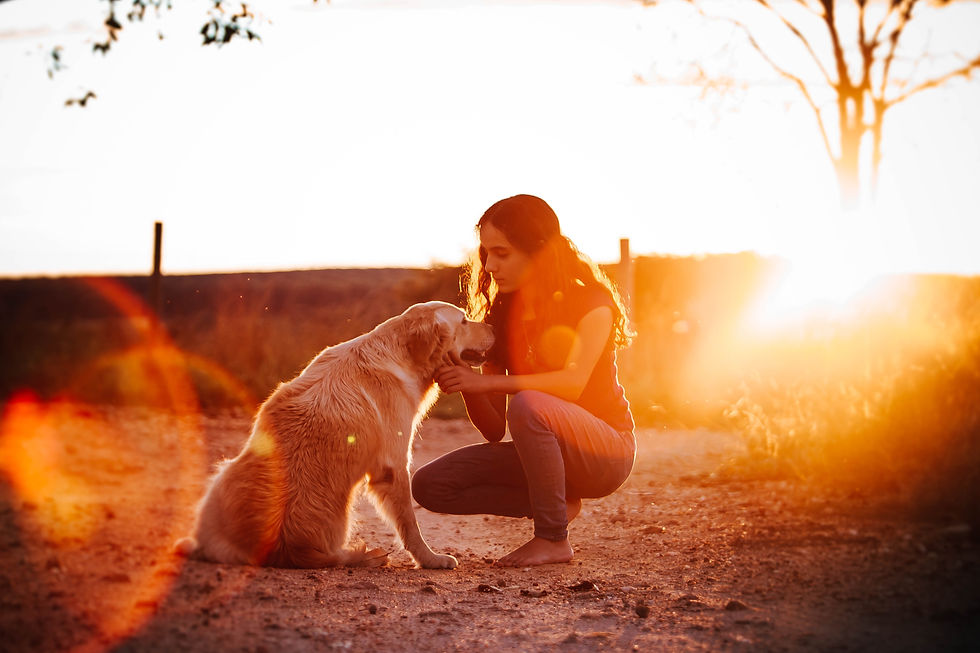Positive Dog Training - Choice Based Learning
- Jan 19, 2023
- 3 min read

Choice based dog training means training a dog using rewards, such as treats, toys, or verbal praise, to reinforce desired behaviours.
This type of training is based on the concept of operant conditioning, which is a method of learning that occurs through rewards and punishments for behaviour. With this type of training, the dog’s behaviouur is shaped and modified through the use of positive reinforcement.
The goal of this type of training is to use rewards to motivate the dog to perform specific behaviours, such as sitting, staying, coming, and walking on a leash. It's better than punishment because it is more effective and it creates a positive relationship between the dog and the owner. It also helps the dog to learn faster and builds a stronger bond between the two. In addition, punishment can create a negative association with certain behaviours, making it much harder to learn and retain new behaviours.
Negative reinforcement means reinforcing or strengthening an existing behaviour by removing an unpleasant stimulus. For example a choke chain might be tight if the dog pulls and loosen when the pulling stops. This type of training is not advised, as it can cause fear and anxiety in dogs and may even lead to aggression.
Teaching Replacement Behaviour in Dog Training
Teaching a replacement behaviour is most fair to a dog because it gives the dog an alternative to the behaviour you don't want. This can be done by teaching the dog a new behaviour and rewarding them for doing it. For example, if the dog is jumping on guests, instead of punishing them, you can teach them to sit and reward them for doing so. This will make them associate the new behaviour with a reward and they will be more likely to do it in the future.
Ignoring a behaviour we don't want might not work as well as teaching a replacement behaviour because the dog may not understand what is expected of them. Ignoring a behaviour may also be difficult to do in certain situations, such as when a dog is jumping on guests. Ignoring the behaviour can also be confusing for the dog if they are being rewarded for similar behaviours.Studies show that dogs trained with positive reinforcement are more likely to learn quickly and retain the behaviors than those trained with negative reinforcement.
The Bond of Positive Reinforcement

Positive reinforcement also creates a stronger bond between the dog and the owner, which can lead to a more enjoyable and successful training experience.
Studies have shown that positive reinforcement is a more effective and successful way to train dogs than aversive methods. For example, a study conducted at the University of Pennsylvania found that dogs trained with positive reinforcement were more likely to obey commands and perform behaviours better than those trained using aversive methods (1).
Similarly, a study conducted by the University of Bristol found that dogs trained with positive reinforcement learned more quickly than those trained with aversive methods (2).
Furthermore, a study conducted at the University of California, Davis found that dogs trained with positive reinforcement were more likely to perform behaviours correctly and be more responsive to commands than those trained with aversive methods (3).
Positive reinforcement also creates a stronger bond between the dog and the owner, which can lead to a more enjoyable and successful training experience. Kind training is ethical and fair to dogs because
It is based on an understanding of the psychology of dogs and their learning needs.
It uses positive reinforcement and rewards to motivate the dog to learn desired behaviors.
It builds an emotional bond between the dog and the owner, promoting trust and cooperation.
It allows the dog to make mistakes without fear of punishment or reprimand.
It helps the dog to learn faster and retain behaviours longer.
It helps to create a safe, enjoyable, and successful learning environment.
Are you a professional dog trainer looking to stay up-to-date on the latest positive reinforcement methods? Join our online dog training course and discover the most effective and ethical ways to teach your canine clients new behaviours!
References
Estep, D. et al. (2004). Reward-based training for dogs: Effects of training methods on obedience and agility performance. Journal of Veterinary Behavior, 5(1), 16-25.
Rooney, N. J. & Cowan, S. (2011). The use of reward-based methods to improve the welfare of companion dogs. Applied Animal Behaviour Science, 132 (3-4), 169-178.3.
Herron, M. E., Shofer, F., & Reisner, I. R. (2009). Survey of the use and outcome of confrontational and non-confrontational training methods in client-owned dogs showing undesired behaviors. Applied Animal Behaviour Science, 117, 47-54.



Comments